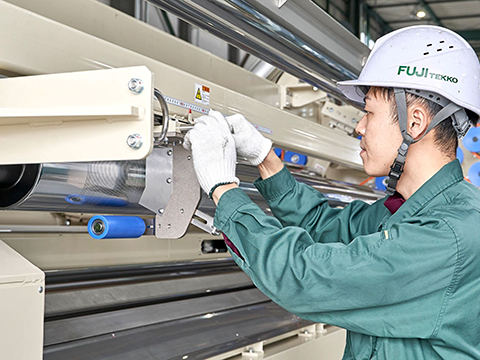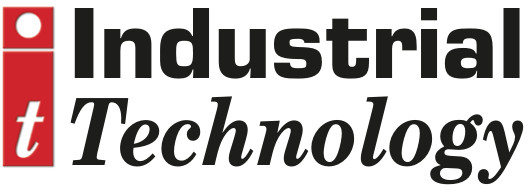
Posted to News on 11th Jun 2025, 09:00
FUJI TEKKO unifies motion, I/O and information communication using CC-Link IE TSN
Winding is a key process in a range of industries from food and beverage, agriculture and electrical engineering to automotive manufacturing, construction and consumer goods. It enables the production of products as diverse as the safety film in your car windscreen and the battery in your mobile phone. The continual development of this mission critical process has been the guiding principle of Japan's FUJI TEKKO since its foundation in 1954, explains John Browett, general manager of the CC-Link Partner Association Europe.

As well as winding machines, FUJI TEKKO designs, develops and manufactures slitters and winding equipment for handling various materials, including paper, plastic films, fibres, rubber, and metals. Slitters are used to cut materials into specified widths and lengths, while winding devices automatically wind products stored on rolls.
The range of machines the company manufactures is enormous; from large-scale units, for wide-width products, up to factory automation scale systems made up of multiple devices. Automatic back-matching blown film winders for agriculture can be the size of a large, four-story home and provide winding widths of five metres.
Notable customers include major international chemical firms as well as global electronics giants. The technical requirements of these kinds of companies mean that FUJI TEKKO's winding machines have had to become continuously faster and more precise, and their control systems have had to develop apace.
The company responds to these complex and diverse needs by designing and manufacturing its machine parts and building its control systems in house, ensuring an enviable level of quality and reliability.
However, historically FUJI TEKKO has run two sets of communications networks on each machine; one dedicated optical communications network delivering servo control and a second Ethernet based network for information communication and other control networks. There has never been another option, because classic network topology doesn't allow for multiple traffic types on a single network.
This leads to increased wiring costs and reduced network flexibility and, crucially, doesn't allow for true real time communication to the microsecond level, something which the rise of the Industrial Internet of Things and Industry 4.0 has made genuinely beneficial.
Time sensitive, mission critical
While FUJI TEKKO has dedicated itself to developing industry leading winding and slitting machines, the CC-Link Partner Association has made its goal the introduction of cutting-edge industrial networking technology.
Notable amongst its innovations has been the combination of open gigabit Ethernet with Time-Sensitive Networking (TSN), in the form of CC-Link IE TSN. Launched in 2018, the CLPA was the first organisation to provide this and, in 2025, remains the only provider on the market.
Underpinning the CLPA's technological development was the irresistible rise of the smart factory, which necessitates gathering real-time information from production processes, processed via edge, cloud or fog computing.
To send this data seamlessly to IT systems a production facility requires a network capable of high-speed, stable control communication and large-volume information transmission. Furthermore, the smart factory demands flexible implementation of equipment supporting mixed usage of information communications.
The CLPA launched CC-Link IE TSN in 2018 to meet this need, with the technology subsequently being used by more than 170 manufacturers in multiple industry sectors worldwide. These include automotive, lithium battery and semiconductor manufacturing, food and beverage processing, consumer packaged goods and electronics.
From sensor to the cloud
To keep pace with the intensive demands of its customers, FUJI TEKKO developed a two-axis turret-type winder, which uses 16 separate servo motors for the winding shaft and the turret rotation mechanism.
Integrating its traditional two network model into a single transparent architecture, from sensor level to the cloud, was a crucial part of its mission, to provide simpler network architecture, greater process transparency, more productivity and greater integration of IT and OT systems.
Crucially, the company also wanted to reduce wiring requirements, to improve profitability and deliver better environmental performance, which a single network would provide. Combining motion communication, IO, and information communication onto a single network, using CC-Link IE TSN was the only answer.
"Using the CC-Link IE TSN connection, we maintain the performance of complex devices like servo amplifiers while enabling the connection of devices like remote I/O, inverters, and sensors that do not require high-speed communication cycles," explained Yasuyuki Sugimoto, General Manager of the Technical Department, at FUJI TEKKO.
"This allows us to maximize each device's performance, thus realising high-speed and high-precision control while meeting customer needs. After delivery, we support our users with a thorough after-service system," he concluded.
System requirements
The system requirements for the project were extremely demanding and, were it not for CC-Link IE TSN, it's likely that FUJI TEKKO would have been unable to find a communications network able to fulfil them.
First among these was motion control performance capable of handling the high speed and high precision of winding machines. It was also important to optimise the overall communication cycle, which was achieved through CC-Link IE TSN only because it allows multiple communication cycles to be used on a single network.
This allows for the high-speed communications required by the servo but permits other IO devices that don't demand such intensive pace to be set to a slow communication cycle.
Finally, it was essential that the Information and communication data required for remote monitoring functions could be mixed in on the same network, to deliver on the promise of reduced wiring and network simplicity.
When things go wrong
The visible network diagnostics provided by CC-Link IE TSN allows the team at FUJI TEKKO to quickly identify problems and automatically distribute parameters and begin to solve the issue in real time. It also makes the remote maintenance of compatible products and IT devices simple, allowing the company to more flexibly resolve customer requests.
But FUJI TEKKO doesn't intend to stop here. In the future, it has plans to further improve maintenance by introducing recording devices onto the network that record equipment status during issues to make predictive maintenance and problem resolution even simpler. Meanwhile innovation won't slow at the CC-Link Partner Association either, as it strives to continue its record of introducing bleeding edge products to market before its competition, just as it did with CC-Link IE TSN and, before that in 2007, with Gigabit industrial ethernet.







